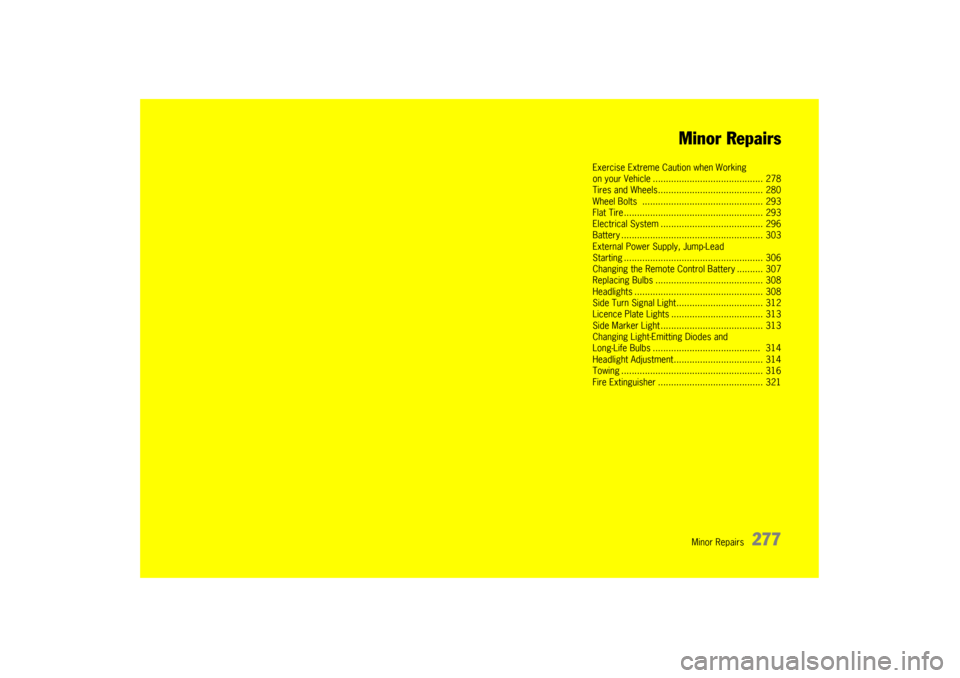2009 PORSCHE PANAMERA flat tire
[x] Cancel search: flat tirePage 266 of 343

264
Maintenance and Car Care
Fuel EconomyFuel economy will vary depending on where,
when and how you drive, optional equipment
installed, and the general condition of your
car.
A car tuned to specifications and correctly
maintained, will help you to achieve optimal
fuel economy.
fHave your vehicle tuned to specifications. Air
cleaner should be dirt free to allow proper
engine “breathing”.
Battery should be fully charged.
Wheels should be properly aligned.
Tires should be inflated to the correct
pressure.
f Always monitor your fuel consumption.
f Drive smoothly, avoid abrupt changes in speed
as much as possible.
f Avoid jack rabbit starts and sudden stops.
f Do not drive longer than necessary in the lower
gears. Shifting into a higher gear early without
lugging the engine will help save fuel.
f Prolonged “warm up” idling wastes gas. Start
the vehicle just before you are ready to drive.
Accelerate slowly and smoothly.
f Switch off the engine if stationary for longer
periods.
f Any additional weight carried in the vehicle
reduces fuel economy. Always keep cargo to
a minimum and remove all unnecessary items. f
Organize your trips to take in several errands
in one trip.
f All electrical accessories contribute to
increased fuel consumption.
f Only switch on the air conditioning when
necessary.
f Do not drive with the Ro of Transport System
mounted unless you need it.
The EPA estimated miles per gallon (mpg) is
to be used for comparison purposes, actual
mileage may be different from the estimated
mpg, depending on your driving speed,
weather conditions and trip length. Your
actual highway mileage may be less than the
estimated mpg.
f Please observe all local and national speed
limits.
Operating Your Porsche in other
CountriesGovernment regulations in the United States and
Canada require that automobiles meet specific
emission regulations and safety standards.
Therefore, cars built for the U.S. and Canada differ
from vehicles sold in other countries.
If you plan to take your Porsche outside the
continental limits of the United States or Canada,
there is the possibility that
– unleaded fuel may not be available;
– unleaded fuel may have a considerably lower
octane rating. Excessi ve engine knock and
serious damage to both engine and catalytic
converters could result;
– service may be inadequate due to lack of proper service facilities, tools or diagnostic
equipment;
– replacement parts may not be available or very difficult to get.
Porsche cannot be responsible for the
mechanical damage that could result
because of inadequate fuel, service or parts
availability.
If you purchased your Porsche abroad and want to
bring it back home, be sure to find out about
shipping and forwarding requirements, as well as
current import and customs regulations.
Page 272 of 343

270
Maintenance and Car Care
High-pressure cleaning equipment
Warning!
High-pressure cleaning equipment can
damage the following components:
–Tires
– Logos, emblems, decorative foils
– Painted surfaces
– Alternator, valve covers
– ParkAssist sensors
– Radar sensor for adaptive cruise control
– Rearview camera
f Always read the operating instructions
provided by the equipment manufacturer.
f Always cover the lid of the brake fluid reservoir
prior to cleaning. Never point the cleaning jet
directly at the lid.
f When cleaning with a flat-jet nozzle or
a so-called “dirt blaster”. maintain a minimum
distance of 20 in. (50 cm).
f Never use high-pressure cleaning equipment
with a round-jet nozzle.
A high-pressure cleaning device fitted with
a round nozzle will damage your vehicle. The
tires are particularly susceptible to damage.
f Do not point the cleaning jet directly at any of the aforementioned components.
Decorative film
Caution!
Risk of damage due to separation of the
decorative film when using high-pressure
cleaning equipment.
f When cleaning components, the water must
not be hotter than 140 °F (60 °C) and the
pressure no greater than 580 psi (40 bar).
Always observe a minimum distance of 20 in. (50 cm).
Care of door lockfTo prevent the door lock from freezing
during the cold season, cover the lock barrel
with suitable adhesive tape while washing
the vehicle.
If the lock still freezes, use an ordinary de-icer.
In many cases, a well warmed key can help.
Never use excessive force.
Car washingThe best protection for the vehicle from the
damaging effects of the environment is frequent
washing and preservation.
The longer road salt, road dust, industrial dust,
insect remains, bird excrement, and tree sap,
resin, pollen, etc. are allowed to remain on the
bodywork, the more harmful their effect.
Observe the following poi nts in order to ensure
that the vehicle is washed thoroughly without
damaging the paintwork:
f The underside of the vehicle should also be
thoroughly washed at the end of the winter
season at the latest.
f Wash your vehicle only at sites provided for
this purpose to prevent soot, grease, oil and
heavy metals from entering the environment.
f Dark colors are slightly more susceptible
to scratching and require particularly careful
paint care.
Dark paints make even the smallest surface
blemishes (scratches) more conspicuous than
lighter colors.
f Do not wash your Porsche in direct sunlight
or when its body is hot.
f When washing by hand, use a car shampoo,
plenty of water, and a soft sponge or washing
brush.
We recommend Porsche car shampoo.
Page 279 of 343

Minor Repairs
277
Minor Repairs
Exercise Extreme Caution when Working
on your Vehicle .......
................................... 278
Tires and Wheels..... ................................... 280
Wheel Bolts ................ .............................. 293
Flat Tire .................. ................................... 293
Electrical System .... ................................... 296
Battery ............................................ .......... 303
External Power Supply, Jump-Lead
Starting ........................................... .......... 306
Changing the Remote Co ntrol Battery .......... 307
Replacing Bulbs ...... ................................... 308
Headlights ....................................... .......... 308
Side Turn Signal Ligh t................................. 312
Licence Plate Lights ................................... 313
Side Marker Light .... ................................... 313
Changing Light-Emitting Diodes and
Long-Life Bulbs ......................................... 314
Headlight Adjustment .................................. 314
Towing ........................ .............................. 316
Fire Extinguisher .......................... .............. 321
Page 283 of 343

Minor Repairs
281
Treadwear
The treadwear grade is a comparative rating
based on the wear rate of the tire when tested
under controlled conditions on a specific
government test course. For example, a tire
graded 150 would wear one and a half (1-1/2)
times as well on the government course as a tire
graded 100. The relative performance of tires
depends upon the actual conditions of their use,
however, and may depart significantly from the
norm due to variations in driving habits, service
practices and differences in road characteristics
and climate.
Traction AA, A, B, C
The traction grades, from highest to lowest, are
AA, A, B, and C and they represent the tire's ability
to stop on wet pavement as measured under
controlled conditions on specified government
test surfaces of asphalt and concrete. A tire
marked C may have poor traction performance.
Warning!
The traction grade assigned to this is based
on braking (straight-ahead) traction tests
and does not include cornering (turned)
traction, acceleration, hydroplaning or peak
traction characteristics. Temperature A, B, C
The temperature grades are A (the highest), B and
C, representing the tire's resistance to the
generation of heat and it
s ability to dissipate heat
when tested under controlled conditions on a
specified indoor laboratory test wheel.
Sustained high temperatures can cause the
material of the tire to de generate and reduce tire
life, and excessive temperature can lead to
sudden tire failure.
The grade C corresponds to a level of
performance which all passenger car tires must
meet under the Federal Motor Vehicle Safety
Standard No. 109.
Grades B and A represent higher levels of
performance on the labora tory test wheel than the
minimum required by law.
Warning!
The temperature grade for this tire is
established for a tire that is properly inflated
and not overloaded. Excessive speed,
underinflation, or excessive loading, either
separately or in combin ation, can cause heat
buildup and possible tire failure, resulting
loss of control, leading to serious personal
injury or death.
Tire pressures
Danger!
Risk of accident.
Risk of serious personal injury or death.
Driving the vehicle with low tire pressure
increases risk of a tire failure and resulting
loss of control. Furthermore, low tire
pressure increases rate of wear of the
affected tires and cause damage.
f Always use an accurate tire pressure gage
when checking inflation pressures.
f Do not exceed the maximum tire pressure
listed on the tire sidewall. (Also refer to
”Technical data“).
f Please see the chapter “TIRE PRESSURE
PLATE” on page 283.
f Cold tire inflation pressure means: all tires
must be cold, ambient temperature maximum
68 °F (20 °C), when adjusting the inflation
pressure. Avoid sunlight striking the tires
before measuring cold pressures, since the
pressures would rise from temperature
influence.
Page 284 of 343

282
Minor Repairs
f
Valve caps protect the valve from dust and dirt,
and thus from leakage. Always screw caps
tightly down. Replace missing caps
immediately.
f Use only plastic valve caps.
f For safety reasons, don't use tire inflating
bottles.
f Please see the chapter “TIRE PRESSURE FOR
COLD TIRES (68 °F/20 °C)” on page 326.
Each tire, including the spare (if provided), should
be checked monthly when cold and inflated to the
inflation pressure recommended by the vehicle
manufacturer on the vehicle placard or tire infla-
tion pressure label. (If your vehicle has tires of a
different size than the size indicated on the vehicle
placard or tire inflation pr essure label, you should
determine the proper tire inflation pressure for
those tires).
As an added safety feature, your vehicle has been
equipped with a tire pressure monitoring (TPM)
that illuminates a low tire pressure telltale when
one or more of your tires is significantly under-
inflated. Accordingly, when the low tire pressure
telltale illuminates, you should stop and check
your tires as soon as po ssible, and inflate them to
the proper pressure. Driving on a significantly
under-inflated tire causes the tire to overheat and
can lead to tire failur e. Under-inflation also
reduces fuel efficiency an d tire tread life, and may
affect the vehicle’s handling and stopping ability. Please note that the TPM is not a substitute for
proper tire maintenance, and it is the driver’s
responsibility to maintain correct tire pressure,
even if under-inflation has not reached the level to
trigger illumination of the TPM low tire pressure
tell-tale.
For further information on the tire pressure
monitoring:
f
Please see the chapter “TIRE PRESSURE
MONITORING (TPM)” on page 127.
When tires are warm, the tire pressure is
increased.
f Never let air out of hot tires. This could cause
the tire pressure to fall below the prescribed
value.
Insufficient tire pressure can cause tires to over-
heat and thus be damaged – even invisibly. Hidden
tire damage is not eliminated by subsequently
correcting the tire pressure. Overloading
Danger!
Risk of damage to vehicle parts, loss of
control and serious pers onal injury or death.
f Do not overload your vehicle. Be careful about
the roof load.
f If you plan to load the vehicle, first correct the
tire pressure. Tire pressure for loaded vehicle
can be found on the tire pressure plate and in
the chapter technical data.
f Never exceed the specified axle load.
Overloading can shorten the service life of the
tires and car, as well as lead to dangerous
vehicle reactions and long braking distances.
Damage due to overloading is not covered by
the vehicle warranty.
Tire damage may also be caused by
overloading, and this damage is not covered by your tire warranty.
f Please see the chapter “LOADING INFORMA-
TION” on page 236.
Page 285 of 343

Minor Repairs
283
Example of a tire pressure plateTire Pressure plateInformation on the tire pressure plate
A Seating capacityMaximum number of vehicle occupants,
including the driver.
B Vehicle load limit Is the maximum total weight limit specified of
the load (passengers and cargo) for the
vehicle. This is the maximum weight of
passengers and cargo that can be loaded into
the vehicle.
Please see the chapter “LOADING
INFORMATION” on page 236. C Original tire size
Size of tires mounted at the factory.
D Recommended cold tire inflation pressure These values are for cold tires (68 °F/20 °C).
Tire traction
Warning!
When driving on wet or slushy roads, a
wedge of water may bu ild up between the
tires and the road. This phenomenon is
known as “hydroplane” and may cause
partial or complete loss of traction, vehicle
control or stopping ability.
f Reduce speed on wet surfaces to prevent this.
Tire lifeTire life depends on various factors, i.e., road
surfaces, traffic and weather conditions, driving
habits, type of tires and tire care.
f Inspect your tires for wear and damage before
driving off. If you notice uneven or substantial
wear, wheels might need alignment or tires
should be balanced or replaced.Tire wearThe original equipment tires on your Porsche have
built-in tire wear indicators. They are molded into
the bottom of the tread grooves and will appear as
approximately 1/2 in. (12 mm) bands when the
tire tread depth is down to 1/16 of an in (1.6 mm).
When the indicators appear in two or more
adjacent grooves, it is time to replace the tires.
We recommend, however, that you do not let the
tires wear down to this extent.
Worn tires cannot grip the road surface properly
and are even less effective on wet roads.
In the United States, state laws may govern the
minimum tread depth permissible. Follow all such
laws.
Page 286 of 343

284
Minor Repairs
Danger!
Driving on worn tires can result in loss of
control of the vehicle and could cause
serious personal injuries or death.
f Do not drive with worn tires or tires showing
cuts or bruises as they may lead to sudden
deflation and loss of control which could cause severe personal injury.
f If you notice that tires are wearing unevenly,
consult your authorized Porsche dealer.
Uneven wear may not alwa ys be due to improper
wheel alignment. It can be the result of individual
driving habits such as cornering at high speeds. If
the tire pressure is no t checked and adjusted
regularly, abnormal tire wear can also occur.
Tire caref Avoid damaging tires and wheel rims.
f I f y o u m u s t d r i v e o v e r a c u r b o r o t h e r o b s t a c l e ,
drive slowly and at an obtuse angle.
f Check tires for uneven wear and damage
before driving off.
f Remove imbedded material.
f Replace worn or damaged tires immediately.
f Keep oil, fuel, brake fluid, etc. away from tires.
f Replace missing valve stem caps.
f Keep tires inflated correctly.
f Wash tires when washing the vehicle. Also
clean inner side of wheels.
f Do not use abrasive cleaners when washing
the wheels.
f Check wheel rims for corrosion.
f Remove road salt, if driving in winter.
Tire damage, puncturefPlease see the chapter “HIGH-PRESSURE
CLEANING EQUIPMENT” on page 270.
Danger!
Risk of serious personal injury or death.
Driving the vehicle with low tire pressure
increases risk of a tire failure and resulting
loss of control. Furthermore, low tire pres-
sure increases rate of wear of the affected
tires.
f Check tires – including sidewalls – regularly for
foreign bodies, nicks, cuts, cracks and bulges.
f Cross curb edges slowly and at right angles if
possible.
Avoid driving over steep or sharp curbs.
f In cases of doubt, have the wheel (particularly
the inner side) checked by an authorized Porsche dealer.
Page 288 of 343

286
Minor Repairs
Self-adhesive weights must not come into contact
with cleaning agents, since they could drop off.
Uneven tread wear indica
tes wheel imbalance. In
this event, the vehicle should be checked at an
authorized Porsche dealer.
Danger!
If, during a trip, uneven running or vibrations
occur that could be caused by damage to
tires or the car, the speed must be reduced
immediately, but without braking sharply. If
you continue your trip without having the
cause of the fault reme died, you might lose
control of your vehicle which could cause
serious personal injury or death.
f Stop the vehicle and check the tires.
f If no cause for the fault can be found, drive
carefully to the nearest authorized Porsche dealer.
Wheels with Tire Pressure Monitoring
(TPM) sensorsBefore changing wheels, make sure that the
wheels are compatible with your vehicle’s TPM.
fCheck this with your authorized Porsche
dealer.Removing and storing tiresfAfter changing, adjust tire pressure and torque
wheel bolts diagonally.
Please see the chapter “CHANGING A WHEEL”
on page 291.
f Store tires in a co ol and dry place. Rotate
periodically to avoid flat spots.
f Avoid contact with fuel, oil and grease.
Tires must always remain on the same side of
the vehicle.
When wheels are removed, the direction of
rotation and position of each wheel should be
marked. Example
FR (front right), FL, RR and RL.
Wheels must always be fitted in accordance with
their marking.
The perception that tire durability and
performance are not affected by storage and age
is unfounded.
Chemical additives, which make the rubber
elastic, lose their effectiveness over the course of
time and the rubber becomes brittle and cracks.
Therefore, the tires should be inspected from
time to time.
Note
Under no circumstances should tires older than
6 years be used on your Porsche.
The age of the tire can be obtained from the ”DOT“
code number. If, for example, the last three
numbers read 1208, then the tire was produced in
the 12th week of 2008.